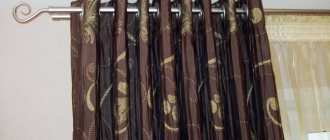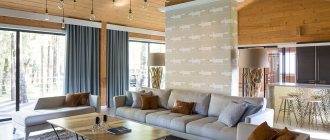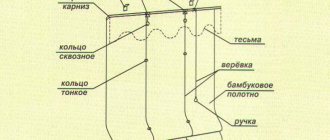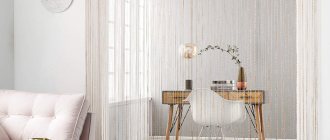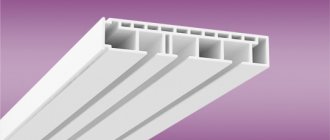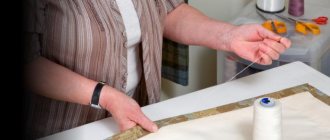We'll tell you how Austrian curtains differ from French and Roman curtains, what control mechanism they have, and what fabrics are used to sew them. After reading, everyone will be able to beautifully decorate the windows in their apartment and choose textiles in accordance with the interior style.
Austrian curtains look very romantic Source suncomfort.ru
What are Viennese curtains?
Viennese curtains are a synthesis of Roman and French curtains. When spread, they look like a straight canvas; when raised, they form lush waves, which are decorated with all sorts of decorative details. The purpose of these curtains is more decorative than practical, since they are sewn from translucent fabrics that cannot protect the room from sunlight.
Despite this fact, many owners of rooms in country, Provence or classic style choose this type of curtain. When sewing Austrian curtains, various fabrics are used:
- polyester,
- atlas,
- organza,
- silk,
- taffeta,
- batiste,
- chintz.
The lower edge of the curtains is decorated with frills, tassels, lace, and ruffles. Preference is given to plain fabrics; light shades (cream, white, beige ivory) are popular. The weight of the product should not be too heavy, as it should be easily lowered and raised using a simple mechanism.
Suitable fabrics
For tailoring, soft, well-draped materials are selected. They can have different densities and ability to transmit light. When choosing fabrics, it is important to take into account the style of the interior, the overall color scheme and the direction of the world on which the windows face.
Tulle
The translucent material drapes easily and lets in a lot of light. Viennese curtains made from this fabric are complemented with classic curtains or lambrequins.
Veil
The rare-woven mesh fabric drapes beautifully, allowing you to create graceful folds. The lower edge of curtains made of this material is decorated with lace, glass beads, and hand stitching.
Organza
Thin translucent fabric is stiffer than tulle. It is assembled into voluminous, breakable folds, thanks to which curtains made from it fill the room with light and give it a special charm.
Guipure
Openwork material is chosen for sewing Viennese curtains if it is necessary to focus attention on the windows. It is decorated with tassels or fringe, giving the interior a solemn look.
Linen
The natural material forms uniform deep folds. It protects the room from prying eyes and excess sunlight.
Velours
Viennese curtains made of this material give the interior a solemn look and are used when decorating windows in large rooms. They are complemented with tassels, lambrequins, cords, and fringe.
Advantages and disadvantages
Before you start sewing such curtains, you should study the advantages and disadvantages of this product so that during further use it does not bring disappointment. The advantages include:
- Easy to use. To open the window to the desired height, you just need to pull the laces. And some models operate from an automatic device;
- Virtually unlimited area of use. Such curtains will fit perfectly into the kitchen interior, decorate the bedroom and living room;
- Ease of care. Viennese curtains are made from lightweight materials that do not accumulate dust or grease. Even if this happens, it will not be difficult to clean them; it is only important to pre-soak them before washing.
However, this piece of furniture also has significant disadvantages:
- Style limitation. The canvases are suitable for rooms designed in classic, Provence, country and similar styles. They will look out of place in a minimalist or high-tech space;
- The fabrics will transmit light and heat, that is, the room will be unprotected from solar radiation and prying eyes when the light is on;
- A difficult manufacturing process that can frighten the craftswoman.
You need to take into account all these nuances before sewing curtains, so that the process of creating them brings only positive emotions.
Benefits of use
Vienna curtains consist of a single piece of fabric and do not slide apart along the edges of the window. When raised, the curtains provide free access to window openings. To adjust their position, simply pull the cord or use the remote control.
Materials and cutting
Before you start creating a product, you need to prepare:
- base for curtains;
- lining fabric (it is used only if you decide to sew a curtain with a lining);
- braid or tightening tape;
- curtain tape;
- nylon cord;
- threads, scissors.
Before cutting out the future curtain, you need to decide on its size. It is enough to take only 2 measurements: determine the height from the cornice to the floor and the length of the cornice.
The width of the finished curtain should be 2 times the length of the cornice. You must not forget about the allowances for processing the edges; to do this, add another 3 cm on each side to the resulting width.
The length of the curtain is calculated based on its location on the window. If the curtain is straight when lowered, then the length is made equal to the distance from the cornice to the floor. If a different position of the drapery is needed, then the length is calculated depending on how the curtain will hang. It is important to remember that Austrian curtains are traditionally “gathered” to the center of the canvas.
To determine the length of the cord, you need to multiply the number of gathering strips by the size of the fabric allocated for gathering. Next, you need to determine how much the cord will exceed the edges of the fabric, the resulting number is multiplied by the number of gathering strips. The two resulting values are added, their sum is equal to the length of the cord.
If mounting tape (curtain tape) is used instead of cord, then measure the length of the fabric allocated for gathering, add allowances to decorate the edges and obtain the length of one strip.
After completing the calculations, cut out the base and lining (if a thick curtain is planned). The following diagram will help you cut the fabric correctly:
What do you need to create Austrian curtains with your own hands?
Handmade allows you to create almost any version of curtains or drapes, and Austrian curtains are the simplest because they do not require the creation of additional layers.
Before sewing curtains you must:
- Choose fabric for curtains and matching laces.
- Choose an option for drapery.
- Take window measurements.
Tools needed for preparation:
- sewing machine,
- ruler, measuring tape,
- needles and pins,
- chalk,
- threads to match the fabric,
- scissors.
Sewing steps
Let's look at the main sewing steps that will help you sew simple Austrian curtains with your own hands. This option does not provide a second layer of material for the wrong side, darts and other complex details.
Stage 1. A piece of fabric of the required size is cut from the material. You need to steam it well to avoid possible shrinkage and changes in the appearance of the product after washing.
Stage 2. Using chalk, mark the places where the curtain tape will pass, which will form voluminous folds. The markings can be applied directly to the canvas or you can use a pre-prepared pattern.
Stage 3. The side fold is sewn on the sewing machine. Its dimensions depend on the type of fabric. For thin material, two centimeters is enough; on dense fabric, three centimeters are left for folding. The seam must be ironed carefully.
Stage 4. The braid is sewn on by hand using a basting stitch. The ribbons located along the edges should be sewn as close to the hem as possible.
Stage 5. The seams are ironed, and then the braid is attached to the curtain.
Important! The upper part of the Austrian curtain is usually flat, it does not form flounces or folds, so the braid does not have to be sewn onto the entire canvas, you can only sew it to the middle. A ribbon is needed for the entire length of the curtain if you plan to frequently change the position of the curtain or buy a special mechanism for lifting it.
Stage 6. Next you need to decorate the top of the canvas. 5 cm of fabric is folded to the wrong side and a seam is made on a sewing machine, choosing threads according to the color of the fabric.
Stage 7. The top is treated with a special curtain tape, sewing it along the seam from the front side.
Stage 8. Turn the tape inside out and stitch it again. After this, only one neat line will be visible on the front side.
Stage 9. After each seam made by the machine, you need to iron it well. Thanks to this, the product will not curl and will look neat.
Stage 10. Decorating the bottom edge. Any decorative elements are sewn to it. After this, the curtain tape is carefully pulled together, and, having received folds, the laces are fixed.
You can use small weights to help the curtains hang evenly. Weights are sewn on the bottom of each gathering cord.
Action plan
When you already have all the necessary materials, you need to determine the size of the canvas itself. To do this, you need to measure parameters such as:
- Cornice width,
- Window height.
Calculation of the width and height of the structure required for sewing should be carried out in accordance with the following recommendations:
- The width of the model should be equal to the width of the cornice plus an allowance for allowances. As a rule, about 3-4 cm are left for allowances, but this largely depends on the texture of the fabric.
- The length of the product is calculated by the formula: the height of the opening is multiplied by two.
Important!
The size of the height largely depends on the interior of the room that will be decorated with hand-made Austrian curtains. For example, for a kitchen, the optimal size would be the height of the window plus a maximum of a meter. This is due to the fact that too lush folds in the kitchen quickly collect dust and dirt.
Smaller allowances, as a rule, range from 10 to 20 cm. This is done so that even when unfolded, the curtains have a gathered structure at the bottom.
The product itself is a rectangle, which is divided into separate strips. These strips indicate where the curtain tape is attached. The distance between them is usually from 30 to 50 cm.
Important!
In specialized stores you can find special braid for Roman blinds; it is ideal for our project.
Curtains made from ready-made curtains
It will be even easier to sew curtains using old curtains. A small master class on how to make them.
- The seams of the curtains are processed: the fabric is folded 5 cm, ironed and the fold is sewn along the upper edge. The bottom can be decorated with anything.
- In the middle and on the sides of each curtain, curtain braid of the required length is sewn, which will ensure that the curtains are gathered into folds. The top of the curtains should remain straight, so no ribbons are sewn to it.
- After finishing sewing the braid, you need to form folds. To do this, pull cords from the braid until the curtains rise to the desired height. During the process, the folds need to be straightened to give them a beautiful look.
- After forming the folds, if you do not plan to open the curtains in the future, you need to tie the cords tightly and trim off their excess part. If the flounces sometimes unravel, then the free edges of the braid laces must be hidden so that they do not spoil the appearance of the curtains.
At the final stage of work, the curtains are hung on the window, the folds are straightened and the updated product is enjoyed.
Drapery
There are many options for how to make drapery for such an interior element. Among them there are those where the cord or elastic band is twisted by hand. But, as a rule, a special braid is used, which can be purchased at any clothing store.
What else do you need to know about curtain tape? It looks like a strip of transparent material through which several thin laces pass. The optimal number is 2. But there are options with one and three laces. This element is sewn to the product at the point where the fold should end. So, the braid is on the sides of the curtain and after each fold. If the braid is not cut off after draping, but tied to the bottom, then you can periodically unravel it and get a smooth fabric. This is convenient during washing. The length of the braid should be to the end of the curtain, starting at a distance of 5-7 cm from the top.
Product care
Caring for wavy curtains is quite simple. You can remove dirt using a washing machine. If the contamination is too heavy, you can briefly soak the curtains in a saline solution.
The curtains are removed from the curtain rod, folded, placed in a bag for washing delicate fabrics, and placed in the machine. Only the gentle wash mode is turned on, excluding strong spinning and water temperatures above 30 degrees. After washing, the curtains should dry, after which they are carefully ironed and returned to their place.
Austrian curtains are an original decorative element that appeared back in the 18th century, capable of adding a touch of luxury and nobility to even a modern room. To make such curtains yourself, you need to be patient and persevering, but in the end you will get an exclusive item that exactly suits the taste of the craftswoman. Curtains from Vienna are suitable for decorating any window space, even non-standard shapes.
Design
The edges of Austrian curtains can be very diverse. To make this decorative element look presentable, use:
- Ruffles,
- shuttlecocks,
- Lace,
- Brushes,
- Beads and seed beads.
Important
! If the material is light enough, make sure that it does not stretch under the weight of the decorative elements.
Width
This calculation includes taking into account the following characteristics:
- Cornice lengths;
- Number of fabric gathers (coefficient);
- Seam allowances.
The working length of the load-bearing part of the cornice, protruding approximately fifteen centimeters from the window opening, is multiplied by the assembly factor.
To correctly calculate drapery, it is necessary to take into account the density of the material. Thin fabric will allow for more folds. Chiffon curtains or voile curtains allow a coefficient in the range of 2-4, for thick curtain fabrics - no more than 1.5-2.0.
Models from leading manufacturers
Famous models of Austrian curtains Black Royal from Domino Metallic, Frazzle Silver, Frazzle Gold, velor curtains IFR Super-Vel, curtains Tergalet-Blaze with colorful trim are spectacularly spectacular.
Mounting options for cornice
There are several options for attaching Viennese curtains:
- to the ceiling;
- wall above the window;
- cornice;
- frame;
- slope above the window.
Curtains can come complete with a curtain rod equipped with a closed or open lifting mechanism.
Velcro
To hang light canvases on the cornice strip, fastening with Velcro tape is used. It consists of soft and hard parts and is attached to a window, wooden plank or wall. When fixing to the cornice, loops are used.
With strings
Curtains with loops and ties look original in the interior. Curtains are secured to the curtain rod using cords, ribbons or textile strips, which are tied with a bow or beautiful knots.
Color solutions
The chosen color of the curtains allows you to create volumes, play with other shades and place accents.
Purple
Romantic and sophisticated, luxurious and sophisticated. Austrian curtains of this color speak of the extraordinary personality of the owner of the apartment.
White
Will make the room brighter. White curtains visually increase the width of the window and harmonize well with pastel-colored walls.
Yellow
A suitable option for creative individuals who like to experiment and want to radically change the interior. After all, with the right combination, yellow Austrians can transform any style.
Orange
Curtains of this color play an important role in the interior. They serve as a bright accent, visually enlarge objects and improve the shade of the furniture in the room.
Beige
They do not draw attention to themselves, but at the same time they look very gentle and stylish, softening the pretentious interior. Sunlight passing through the beige fabric brings warmth and comfort to the room.
Brown
These chocolate curtains make the room look fresher, add a touch of novelty and allow you to experiment with color.
Turquoise
Reminds me of a summer breeze. Turquoise Austrian curtains are associated with depth and purity; they exude coolness and freshness.
Blue
Create a balanced and harmonious interior. Their shades have many variations and combine perfectly with almost the entire palette, evoking a feeling of genuine admiration.
Reds
They bring ceremony and theatricality to the interior. Curtains of this color can warm the room and make it more cozy and welcoming.
Photos in the interior of the rooms
If the interior lacks a bright accent, then Austrian curtains can give a luxurious look to any living room.
Kitchen
A profitable option for the kitchen. If the window is located near a stove or sink, such curtains can save space, since the canvas can be raised up as much as possible.
In the photo there is a kitchen and windows with Austrian curtains.
Children's
Curtains will look more attractive if you decorate them with a variety of accessories. Bows, ribbons and frills are suitable. By color, bright and rich shades or a variety of patterned fabrics are often chosen for children's rooms.
Living room
When decorating the living room with Austrian curtains, do not forget about lighting. Correctly falling light will give the curtain composition even more charm, highlight the amazing patterns and fill the room with comfort.
Bedroom
They will create an atmosphere of romance and add mystery to the room. Beige or white colors are used for decoration to make the room look even more elegant and delicate.
The photo shows a bedroom interior in beige tones and a window decorated with Austrian curtains.
To the loggia (balcony)
Look good on long loggias. Austrian women are suitable for elongated spaces and do not seem boring and monotonous.
Cabinet
They will add some solemnity to the entire work space. Such curtains are sometimes combined with long drapes to create a complete window decor.
Useful tips
“Austrians” look unusual and elegant when the ribbon is sewn only in the central part, and not on the sides. In this case, the edges of the fabric will hang freely and give the window a sophisticated and glamorous look.
For Austrians, hidden or discreet frames are most suitable. They visually enlarge the room and do not attract attention to themselves, emphasizing the elegant beauty of the curtains. This rule is especially true for small kitchens with small windows that do not tolerate unnecessary details that burden the space.
Curtains made from two fabrics of different textures and colors look good on any window. They are based on transparent organza or tulle, and in addition - a stylish material suitable for the kitchen interior. Such a curtain should not be collected in numerous folds. It is better to decorate with thin ribbons and bows.
The door of a balcony or loggia is usually decorated with a long curtain. So that it does not stand out from the overall design concept of the room, it is complemented by a short Austrian curtain, reminiscent of a lambrequin and similar in shape and texture to a window curtain.
The new is the well-forgotten old. Good old Austrian curtains have brought elements of novelty and sophistication to modern interiors. Thanks to the ability to constantly change shape, you can also change the appearance of the kitchen, filling even the most ordinary and expressionless atmosphere with bright and original colors.
Fabric colors
When choosing a pattern and color of a material, it is important to take into account the features of the interior, the area of the room and the degree of its illumination. It is not necessary to use plain fabrics.
With flowers
Flowers on the curtains soften the atmosphere and bring a feeling of celebration. Light and sophisticated designs create a joyful and soulful atmosphere in the interior.
Floral patterns
When decorating windows, designers often use curtains with fashionable patterns. The canvases contain curls, vines, leaves, petals and other natural elements.
Ornaments
Original drawings focus attention on the windows and transform any room. Viennese curtains with patterns add sophistication and charm to the simplest furnishings.
Geometry: stripe, check
Curtains with clear geometric patterns add laconicism and rigor to the decor. They are appropriate in living rooms, offices, and kitchens. Light draperies and waves along the edge soften the overall appearance.
